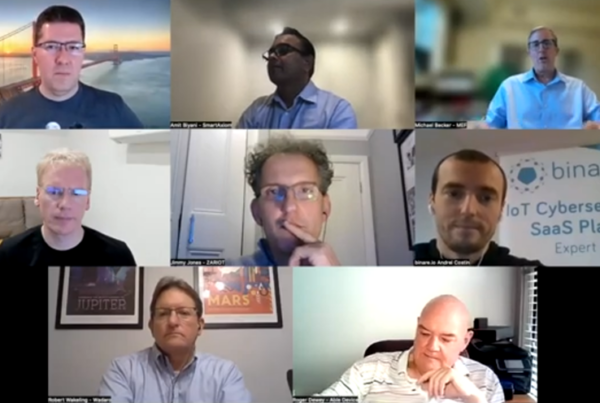MEF Programme Director for IoT Nassia Skoulikariti shares her thoughts from a recent MEF IoT Working Group meeting, where Stefano Nicoletti, an expert in telecom regulation, spoke about drone regulations within the IoT framework. Find out more about how the commercial drone industry is influencing IoT regulation.
The drone industry is a complex ecosystem with many stakeholders involved. The lack of a cohesive regulatory framework has been cited as one of the main reasons for slow growth in this sector.
The potential for disruption due to the lack of unified regulations is high, especially given how fast technological advances are happening today.

During the April IoT Working Group here at MEF, Stefano Nicoletti, an expert in telecom regulation, gave an insightful talk about drone regulations within the IoT framework. Nicoletti covered various aspects of the drone industry, from the different types of drones to the stakeholders involved.
The Benefits of Automation
The benefits of automation in the drone industry are numerous. For example, it can improve safety and efficiency by allowing drones to fly rather than having humans pilot them. This is especially true with larger drones that require more complex flight patterns and manoeuvres.
Automated systems also help minimize costs by reducing labour costs associated with manual processes such as inspection or data collection. In addition, they allow companies to scale up their operations without hiring additional staff members; instead, they can rely on software programs that do not require human intervention once set up correctly (although there may still be some need for oversight).
The challenges of drone regulation are many. There is a need for a comprehensive regulatory framework that can address all aspects of drone use. Enforcing these regulations will be difficult because drones are mobile and can easily cross borders.“
Nicoletti emphasized the importance of automation in the drone industry, stating that it is “essential for lowering the barrier to entry to the drone market” and “enables unmanned traffic management service providers to adapt and reroute flights in real-time, making drone operations more efficient and safe.”
Regarding the use of cellular licenses for drones, Nicoletti noted that Ofcom has authorized their use and conducted work on interference, but there are limitations surrounding specific frequencies like 2.6GHz. He also discussed the potential of using the Secure Element (SE) in mobile phones as a powerful authentication mechanism for identifying drones and ensuring communication privacy and security.
Exciting Developments in the Field
There are a lot of exciting developments in the field. For example, we increasingly use cellular networks to enhance drone connectivity and command-and-control capabilities. This could be used for things like medical deliveries, where you want to have a reliable link between the drone and your base station to get accurate information about where it is at any given moment.
One exciting development in the drone industry that Nicoletti discussed was the potential for drones to reduce transportation time between hospitals and reduce carbon emissions by up to 90% compared to traditional vans. BT, a telecoms provider in the UK, is already conducting test flights with Skyfarer, an expert in medical deliveries via drones.
Another area I think will see growth is using drones as part of large infrastructure projects like building bridges or tunnels; these projects require very accurate surveying data, which drones can provide quickly and efficiently compared with traditional methods like lasers or GPS surveying equipment.
The Challenges of Drone Regulation
The challenges of drone regulation are many. There is a need for a comprehensive regulatory framework that can address all aspects of drone use. Enforcing these regulations will be difficult because drones are mobile and can easily cross borders. There is also the potential for misuse of drones by malicious actors who may use them as weapons or to spy on people’s private lives–an issue that has been raised recently concerning Amazon’s delivery service Prime Air.
Nicoletti also delved into the complex nature of the drone industry, discussing the various stakeholders involved, such as regulators like Ofcom and the Civil Aviation Authority, as well as associations like the Standards Institute and GSMA. He noted a need for a comprehensive regulatory framework to address all drone use aspects.
Furthermore, Nicoletti discussed the potential of using the IMS codes, an international standard for identifying devices on cellular networks, to identify drones. He noted that most drones currently do not have SIM cards, so there are two options for equipping them with the necessary technology to be identified – either by incorporating a SIM slot or using a device that attaches to the drone.
The Future of Drone Regulations
As we move into an age of automation and AI, it is important to have a cohesive regulatory framework that allows for innovation while protecting consumers. The potential of drones in our everyday lives is exciting, but only if we can get past the barriers of regulation and bureaucracy.
The industry has come a long way since it first emerged, and we’ve seen some significant developments in recent years. The need for a unified regulatory framework is becoming more apparent. While there are still many questions that need answering, the potential for increased safety and efficiency is undeniable if regulations can be streamlined across all industries–from agriculture to construction to mining–so that companies can focus on what they do best: creating new products with innovative technology that will improve lives around the world.
Conclusion
As we move into an age of automation and AI, it is important to have a cohesive regulatory framework that allows for innovation while protecting consumers.
The report and the talk during the MEF IoT working group by Nicoletti’s talk provided in-depth insights into the complex nature of the drone industry, the importance of automation, and the various stakeholders involved.
His talk also highlighted exciting developments in the drone industry, such as their usage in medical deliveries and the potential of using cellular networks to enhance drone connectivity, command, and control.
The potential of drones in our everyday lives is exciting, but only if we can get past the barriers of regulation and bureaucracy and ensure secure operation and management.





